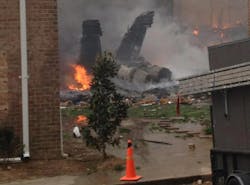Va. Beach Fire Official Recalls Jet Crash Response
April 12--VIRGINIA BEACH -- Virginia Beach fire district chief Mike Barakey had just sat down at CP Shuckers on Pacific Avenue around noon Friday when his waitress pointed out the window toward 24th Street and Birdneck Road.
"Is that normal?" she asked, motioning to a huge plume of smoke.
He threw down enough cash to cover the salad he had ordered and sped out. His pager went off.
Dispatchers had already sent seven fire engines, three ladder trucks, three ambulances and a handful of other response vehicles to the scene where a Navy jet had plummeted into a cluster of apartment buildings, igniting several.
As Barakey approached the crash site, he saw buildings on fire and clouds of smoke. He ordered an even larger response.
As the highest-ranking fire official on scene, Barakey became the department's initial incident commander -- the person responsible for making decisions that could save or end lives.
The plane had crashed into the large Mayfair Mews apartment complex.
He surveyed the blazing units, wondering, what was survivable? The F/A-18D had sliced one building in two. Barakey decided not to have people dig through the rubble, thinking it risky and likely fruitless. Instead, he directedfirefighters to conduct searches of the burning buildings that were at that point still intact. Some of the firefighters went in without water lines for protection.
He had to risk a lot to save a lot, he said. So he sized up the scene and hoped he made the right choices.
He expected civilian casualties.
Soon hundreds of first responders were on scene. Police secured the area as spectators swarmed and medics amassed, prepared for the worst. Officials from the Navy, Virginia State Police, and local police, fire and emergency medical services set up a command post.
While the crash presented unusual challenges -- hazardous materials, the potential for mass fatalities and national media attention -- officials said they were well prepared. That's partly thanks to past incidents such as hurricanes, and, oddly enough, even the strawberry festival.
Leaders from each of the agencies with a stake in the incident worked side-by-side in a unified command to share information and make decisions, just as they would when covering a routine festival, Virginia Beach EMS Division Chief Bruce Nedelka said. That helps prepare for a crisis.
At such scenes, command works like a pyramid, he said, with a handful of experienced decision-makers at the top and hundreds of responders carrying out their decisions. That allows dozens of people to work together without mass confusion, he said.
It takes more than a few festivals, though, to be ready when an aircraft strikes an apartment complex. First responders have also trained with the Navy specifically for jet crashes.
In December, crews from Virginia Beach and Chesapeake prepared for a scenario eerily similar to what unfolded on Good Friday. That exercise simulated an air crew safely ejecting in Chesapeake and an F/A-18 crashing in Virginia Beach. A practice ejection seat was placed at the scene so responders could learn how to approach it.
This year, all Virginia Beach firefighters went to Oceana Naval Air Station for an aircraft fire-fighting drill and instruction on the dangers of a military aircraft, said Battalion Chief Tim Riley, a Virginia Beach Fire Department spokesman.
First responders said the extensive training made the transition from practice to reality seamless.
"It was like going to a book you have already read and opening it up to the second chapter," Riley said. "You've already read it so you knew exactly where to go."
The Good Friday crash was measured in a series of benchmarks. In less than half an hour, responders had obtained a list of people registered as living in the complex and began making calls to account for them. After another 30 minutes, crews had reduced the fire to steam and smoke. By that time Deputy Fire Chief Randy Journigan had taken over as incident commander and Barakey assumed control of fire operations.
Barakey and others were surprised when an initial search of the apartment complex didn't reveal any casualties. A second round confirmed the findings.
How could that be? We must be missing something, Barakey thought.
Medics at Sentara Virginia Beach General Hospital monitored the EMS radio and ambulances. EMS personnel lined stretchers along Birdneck Road waiting to triage patients who never materialized. Only a handful of people, including the two pilots, were taken to hospitals for minor injuries and smoke inhalation.
Tuesday, Mayor Will Sessoms thanked crews for doing an "absolutely superb job."
"The training that has occurred over the years with fire, EMS and police, along with state agencies and federal agencies, we'd always hoped wouldn't have to be used," he said at a City Council meeting. "But it was used. And I would sit back and say to you that it was extraordinary how well everyone performed."
Firefighters were honored at Harbor Park during the home opener for the Tides on Monday. Deputy Chief Journigan even got to throw out the first pitch.
Days after the crash, life is just beginning to return to normal for Barakey. He's been back to the crash site, but mostly he's been focused on putting everything that happened down on paper. A report on the fire will be sent to the state Department of Fire Programs, he said.
Barakey said he's pleased with the work they did.
"I'm proud of everyone who performed," he said. "We did everything we could have."
An interview with The Pilot late Tuesday afternoon was Barakey's first chance to talk about what happened, he said. He was still tired.
As he talked, his radio crackled to life.
Back to work.
Sarah Hutchins, 757-222-5131, [email protected]
Copyright 2012 - The Virginian-Pilot, Norfolk, Va.
